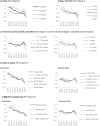Swedish Fertility Developments Before, During and After the COVID-19 Pandemic
- PMID: 40691363
- PMCID: PMC12279657
- DOI: 10.1007/s10680-025-09744-8
Swedish Fertility Developments Before, During and After the COVID-19 Pandemic
Abstract
Many affluent societies saw a temporary increase in their fertility rates in 2021, during the COVID-19 pandemic. This included a number of countries that had experienced fertility decline during the 2010s, like the Nordic. In the immediate aftermath of the pandemic (2022-2023), fertility rates resumed their previous downward trend. Most research on the pandemic-related fertility trends has relied on aggregate data. Although a few studies have examined group-specific trends, hardly any have covered the post-pandemic years-an important step for revealing whether any uptick in 2021 had a lasting impact on fertility structures. Our study attends to this objective, with a focus on parity and group-specific fertility trends in Sweden before, during and after the COVID-19 pandemic. We apply event-history techniques to Swedish register data to unveil annual trends of birth risks in 2010-2022, for all Swedish-born women of childbearing age. First- and second-birth risks in 2015-2022 are analysed further across socio-demographic factors. Our study reveals that the "pandemic pattern" of fertility increase in 2021 and drop in 2022 was visible among subgroups with better possibilities to prepone already intended births. For example, the fertility increase and subsequent drop was particularly evident for mothers with young children and women with higher education and incomes. The pandemic fertility pattern reflects temporary changes in the timing of childbearing, more specifically a preponement of births that occurred in 2021 with resulting shortfall in 2022. The continued fall in fertility rates in 2023 should be viewed in the light of the long-term fertility decline.
Keywords: COVID-19; Fertility; Fertility trends; Pandemic; Sweden.
© 2025. The Author(s).
Conflict of interest statement
Declarations. Conflict of interest: The authors declare that they have no competing interests. Consent for Publication: Not applicable. Ethical Approval: This research has been approved by the ethics committee “Regionala etikprövningsnämnden i Stockholm (EPN)”, with reference number 2018/1451–31/5.
Figures











Similar articles
-
Signs and symptoms to determine if a patient presenting in primary care or hospital outpatient settings has COVID-19.Cochrane Database Syst Rev. 2022 May 20;5(5):CD013665. doi: 10.1002/14651858.CD013665.pub3. Cochrane Database Syst Rev. 2022. PMID: 35593186 Free PMC article.
-
Risk of thromboembolism in patients with COVID-19 who are using hormonal contraception.Cochrane Database Syst Rev. 2023 Jan 9;1(1):CD014908. doi: 10.1002/14651858.CD014908.pub2. Cochrane Database Syst Rev. 2023. Update in: Cochrane Database Syst Rev. 2023 May 15;5:CD014908. doi: 10.1002/14651858.CD014908.pub3. PMID: 36622724 Free PMC article. Updated.
-
Antidepressants for pain management in adults with chronic pain: a network meta-analysis.Health Technol Assess. 2024 Oct;28(62):1-155. doi: 10.3310/MKRT2948. Health Technol Assess. 2024. PMID: 39367772 Free PMC article.
-
Use of endoanal ultrasound for reducing the risk of complications related to anal sphincter injury after vaginal birth.Cochrane Database Syst Rev. 2015 Oct 29;2015(10):CD010826. doi: 10.1002/14651858.CD010826.pub2. Cochrane Database Syst Rev. 2015. PMID: 26513224 Free PMC article.
-
Sexual Harassment and Prevention Training.2024 Mar 29. In: StatPearls [Internet]. Treasure Island (FL): StatPearls Publishing; 2025 Jan–. 2024 Mar 29. In: StatPearls [Internet]. Treasure Island (FL): StatPearls Publishing; 2025 Jan–. PMID: 36508513 Free Books & Documents.
References
-
- Aassve, A., Cavalli, N., Mencarini, L., Plach, S., & Livi Bacci, M. (2020). The COVID-19 pandemic and human fertility. Science,369(6502), 370–371. 10.1126/science.abc9520 - PubMed
-
- Aassve, A., Cavalli, N., Mencarini, L., Plach, S., & Sanders, S. (2021). Early assessment of the relationship between the COVID-19 pandemic and births in high-income countries. Proceedings of the National Academy of Sciences of the United States of America (PNAS). 10.1073/pnas.2105709118 - PMC - PubMed
-
- Andersson, G. (2004). Childbearing after migration: Fertility patterns of foreign-born women in Sweden. International Migration Review,38(2), 747–775. 10.1111/j.1747-7379.2004.tb00216.x
Grants and funding
LinkOut - more resources
Full Text Sources
